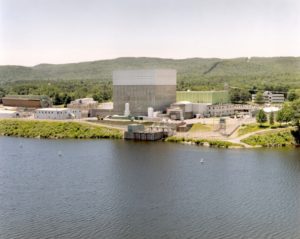After several weeks of negotiations, Vermont Yankee nuclear power plant owner Entergy, potential buyer NorthStar, state agencies, and citizen activists have come to an agreement on how the shut down plant could be transferred and decommissioned by NorthStar.
One agency, however, does not think the plan has enough financial supports in place if something unexpected happens.

Vermont Yankee Nuclear Power Plant. Wikimedia Commons photo from the U.S. Nuclear Regulatory Commision
NorthStar had proposed to buy the plant so that it could decommission the plant, which shut down in 2014, decades earlier than Entergy. While Entergy said it could complete the process by 2072, NorthStar said it would be finished by 2052, with partial restoration of the site by 2030 or even earlier.
Schuyler Gould, president of the New England Coalition on Nuclear Pollution, said his organization had signed off on the agreement, a memorandum of understanding that was released on Friday, March 2.
“We feel on balance that this is a good deal for the state of Vermont and we’re ready to move forward with that and support NorthStar’s efforts,” he said.
The New England Coalition on Nuclear Pollution, a safe energy advocacy group focused on the hazards and risks of nuclear power, was one of 10 groups at the table during closed-door negotiations over the document, including Entergy, Northstar, the Vermont Department of Health, the Vermont Attorney General’s Office, and two Native American Tribes.
In the end, the only organization of the 10 not to sign onto the document was the Conservation Law Foundation, a law-oriented environmental advocacy group.
Sandra Levine, senior attorney with the Conservation Law Foundation, said the agreement did not create enough of a financial safety net if something unexpected comes up during the clean up.
“NorthStar … is taking all the responsibility for the clean up under a shell corporation with no assets of its own,” she said. “Entergy would no longer be on the hook and no longer be able to step in as a back stop. There is insufficient insurance in place if something goes wrong.”
Levine said there were not incentives established in the agreement to make sure NorthStar does a good job with the clean up.
“There’s a long history of cost overruns in cleaning up old nuclear power plant sites,” she said.
Mike Twomey, vice president of external affairs for Entergy Wholesale Business, said Entergy presented the transfer proposal in December of 2016, and that it has “tremendous benefits” for the state of Vermont.
Those include “a safe and efficient decommission led by a firm that has significant expertise in decommission work and an earlier cleanup compared to our work,” he said.
Twomey said Entergy purchased the Vermont Yankee facility in 2002 and took on all of the liability at that time from the New England utilities that had previously owned it.
“They transferred the site to us, and the The Vermont Public Utility Commission at the time approved it,” he said. “We’re proposing a similar transaction.”
For Ray Shadis, a technical adviser for the New England Coalition with decades of experience working with the federal Nuclear Regulatory Commission on past decommissioning projects, said the memorandum of understanding was not perfect, but it was good.
Shadis said the New England Coalition was pushing mainly for two objectives: environmental protection and public participation.
On the former point, Shadis had hoped NorthStar would commit to cleaning up the site to the have only 10 millirems above background of radiation, as was done for Maine Yankee and Rowe Yankee in Massachusetts, decommissioned in 2005 and 2007 respectively.
NorthStar committed to 15 millirems, but the memorandum of understanding includes language that states NorthStar “shall attempt to attain” 10 millirems. An average person in the United States is exposed to 620 millirems per year, according to the Environmental Protection Agency, and the Nuclear Regulatory Commission states nuclear plant sites can have a maximum of 25 millirems above background.
“We don’t have a contract that says they are absolutely going to do this, but we have a contract that says they are going to try,” Shadis said. “So unless there is some monster pocket of hidden radiation left there that they don’t know about, I think we’re good.”
Shadis also said that the Coalition has NorthStar’s attention and the entities will continue a dialog, and that the door is open for informed members of the public to get involved.
Twomey said the memorandum of understanding is an important step in the process but that the transfer is not complete. The corporation will still have to persuade the Vermont Public Utility Commission that it is a transaction that is in the public interest and the federal Nuclear Regulatory Commission also had to agree.
There will be testimony from the organizations involved in addition to the memorandum of understanding document, including from the Conservation Law Foundation.
Levine said they support the concept of transferring ownership, but believe a better financial structure should be in place.
“If the proposal is such a good deal, Entergy and NorthStar should stand behind it more solidly,” Levine said. “They shouldn’t be requiring Vermonters to be left holding the bag if something goes wrong.”
Dave Eisenstadter can be reached at deisen@valleyadvocate.com.


